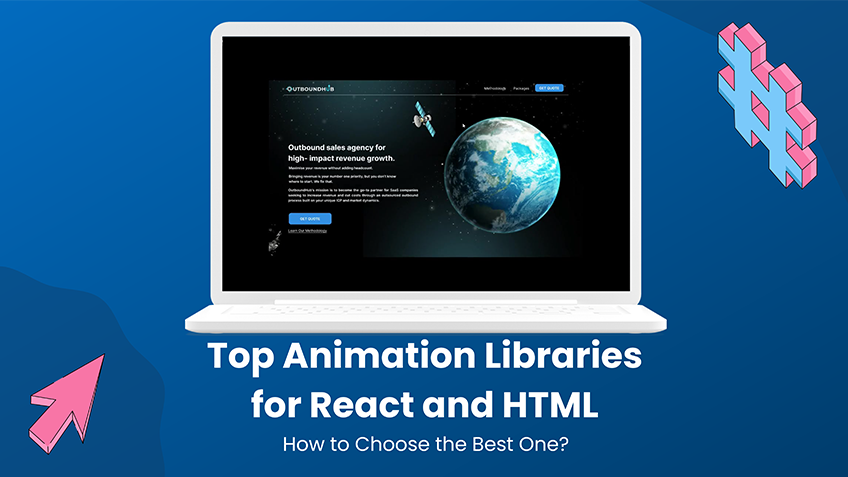Animations play a crucial role in modern web design by enhancing user interaction and improving the overall user experience. From subtle hover effects to complex transitions, animations bring websites to life. When it comes to creating these animations, developers often rely on various libraries that simplify the process and offer a wide range of features.
How Libraries Are Used for Animations?
Animation libraries are collections of pre-written code that allow developers to implement complex animations quickly. They provide functions and components that take care of the intricate details behind the scenes, letting developers focus on how the animations should look and behave.
For example, libraries like GSAP (GreenSock Animation Platform) or Anime.js enable you to create intricate timelines of animations with smooth transitions, without worrying about the low-level technicalities of browser rendering.
Advantages of Using Animation Libraries:
- Simplifies Complex Animations: They provide easy-to-use APIs that handle the math and logic behind animations.
- Cross-Browser Compatibility: Many libraries ensure that animations work consistently across different browsers.
- Performance Optimized: Most popular libraries are optimized to run efficiently, minimizing performance issues on the browser.
How Animation Libraries Work in React?
React, as a JavaScript library for building user interfaces, handles updates to the DOM (Document Object Model) through a virtual DOM, making it fast and efficient. When adding animations to React applications, it’s essential to choose libraries that can integrate seamlessly with this virtual DOM.
Animation in React: Key Considerations
State-Driven Animations: Since React relies on state and props, animation libraries need to interact with state changes effectively. React-compatible libraries use hooks or higher-order components (HOCs) to integrate animations.
Declarative Approach: React’s declarative programming style makes it easier to define animations as part of the component lifecycle. This means that you can trigger animations when certain conditions (like state changes) are met.
Popular Libraries for React Animations:
- Framer Motion: This is a highly popular animation library designed specifically for React. It uses a simple syntax and integrates well with React’s component structure. Framer Motion is known for its performance and flexibility.
- React Spring: React Spring is a physics-based animation library that allows for smooth, realistic animations. It’s perfect for complex animations that require fluid transitions.
- React Transition Group: A lower-level library, it gives you more control over animations but requires more manual work.
How Animation Libraries Work in HTML?
In vanilla HTML (along with CSS and JavaScript), animations are often handled using CSS transitions, keyframes, or JavaScript functions. Unlike React, HTML has direct access to the DOM, which simplifies the process in some ways but makes performance optimization more manual.
Key Considerations for HTML Animations
CSS Animations and Transitions: CSS provides a native way to animate properties like position, opacity, color, and more. These can be used without additional libraries but lack advanced control over the timing and sequencing of animations.
JavaScript-Based Animations: For more complex animations that require timelines, interactions, or physics-based motion, developers rely on JavaScript libraries. These libraries manipulate DOM elements directly to create smooth animations.
Popular Libraries for HTML Animations:
- GSAP: The GreenSock Animation Platform is one of the most powerful and widely used animation libraries. It allows for both simple and complex animations, with excellent performance even in heavy animations.
- Anime.js: This lightweight JavaScript animation library offers a simple API for creating animations. It supports complex timelines and is flexible enough for both basic and advanced use cases.
- Velocity.js: Velocity is an animation engine designed for the performance-conscious developer. It integrates well with jQuery and can animate many CSS properties.
Differences in Animation Libraries Between React and HTML
The primary difference between how libraries work in React versus HTML is the way animations are triggered and handled.
DOM Manipulation:
- React: React does not directly manipulate the real DOM; instead, it uses a virtual DOM. Thus, animation libraries must work within React’s virtual DOM and declarative style.
- HTML: HTML animations directly manipulate the real DOM, providing more straightforward control but without React’s efficiency in handling UI updates.
Component Lifecycle:
- React: Animations can be tied to component lifecycle events (like
componentDidMountoruseEffect), making it easier to trigger animations based on state changes. - HTML: Animations in HTML rely more on event listeners or CSS classes to trigger changes.
Performance:
- React: While React’s virtual DOM optimizes re-renders, some animation libraries may struggle with performance if not properly optimized for React.
- HTML: Direct DOM manipulation in HTML can sometimes lead to janky animations if too many elements are being animated at once.
Which Animation Libraries are Compatible with React and HTML?
Compatible with React:
- Framer Motion: Designed specifically for React, making it ideal for state-driven animations.
- React Spring: Suitable for complex animations that need physics-based transitions.
- React Transition Group: Provides fine-grain control over transitions between states.
Compatible with HTML:
- GSAP: Works seamlessly with vanilla JavaScript and HTML, perfect for complex timelines.
- Anime.js: Lightweight and easy to use for general-purpose animations in HTML.
Feeling like your website is a little too dull?
If you’re ready to bring it to life with stunning animations, let’s chat! Contact me today and let’s transform your site together!
Feel free to connect with me – https://sahilkaul.com/
Hire me – https://www.upwork.com/freelancers/sahilkaul1996
How do animation libraries enhance website design?
Animation libraries simplify the process of creating smooth, complex animations, making websites more interactive and visually appealing.
Can I use the same animation library for both React and HTML?
Some libraries, like GSAP, work well with both React and HTML, while others, like Framer Motion, are built specifically for React.
Is CSS animation better than JavaScript animation?
For simple transitions and hover effects, CSS animations are usually more performant. However, for more complex animations, JavaScript libraries like GSAP offer greater flexibility and control.
What’s the best animation library for React?
Framer Motion is one of the most popular choices for React due to its simplicity, flexibility, and performance.
Is GSAP compatible with React?
Yes, GSAP can be used in React, but you need to ensure that it works harmoniously with React’s virtual DOM.
How can I improve animation performance in React?
To optimize animation performance in React, use libraries designed for React, like Framer Motion or React Spring, and avoid unnecessary re-renders by optimizing your components.
If you're looking for any services regarding Digital Marketing or Website Developement, Please Contact now.



Leave a Comment